2024.09.23
- Features
-
Services/ProductsServices/ProductsServices/Products

Learn more about the retail trading conditions, platforms, and products available for trading that FXON offers as a currency broker.
You can't start without it.
Trading Platforms Trading Platforms Trading Platforms
Features and functionality comparison of MetaTrader 4/5, and correspondence table of each function by OS
Two account types to choose
Trading Account Types Trading Account Types Trading Account Types
Introducing FXON's Standard and Elite accounts.
close close

-
SupportSupportSupport

Support information for customers, including how to open an account, how to use the trading tools, and a collection of QAs from the help desk.
Recommended for beginner!
Account Opening Account Opening Account Opening
Detailed explanation of everything from how to open a real account to the deposit process.
MetaTrader4/5 User Guide MetaTrader4/5 User Guide MetaTrader4/5 User Guide
The most detailed explanation of how to install and operate MetaTrader anywhere.
FAQ FAQ FAQ
Do you have a question? All the answers are here.
Coming Soon
Glossary Glossary GlossaryGlossary of terms related to trading and investing in general, including FX, virtual currencies and CFDs.
News News News
Company and License Company and License Company and License
Sitemap Sitemap Sitemap
Contact Us Contact Us Contact Us
General, personal information and privacy inquiries.
close close

- Promotion
- Trader's Market
- Partner
-
close close
Learn more about the retail trading conditions, platforms, and products available for trading that FXON offers as a currency broker.
You can't start without it.
Features and functionality comparison of MetaTrader 4/5, and correspondence table of each function by OS
Two account types to choose
Introducing FXON's Standard and Elite accounts.
Support information for customers, including how to open an account, how to use the trading tools, and a collection of QAs from the help desk.
Recommended for beginner!
Detailed explanation of everything from how to open a real account to the deposit process.
The most detailed explanation of how to install and operate MetaTrader anywhere.
Do you have a question? All the answers are here.
Coming Soon
Glossary of terms related to trading and investing in general, including FX, virtual currencies and CFDs.
General, personal information and privacy inquiries.
Useful information for trading and market information is posted here. You can also view trader-to-trader trading performance portfolios.
Find a trading buddy!
Share trading results among traders. Share operational results and trading methods.
- Legal Documents TOP
- Client Agreement
- Risk Disclosure and Warning Notice
- Order and Execution Policy
- Complaints Procedure Policy
- AML/CFT and KYC Policy
- Privacy Policy
- eKYC Usage Policy
- Cookies Policy
- Website Access and Usage Policy
- Introducer Agreement
- Business Partner Agreement
- VPS Service Terms and Condition

This article was :
published
updated
Weekly FX Market Review and Key Points for the Week Ahead
As the central banks in the U.S., U.K. and Japan announced their monetary policies last week, the foreign exchange markets, especially the USDJPY, showed momentum.
In particular, the FOMC's announcement of a 0.50% interest rate cut led to a temporary sell-off in the USD. However, post-FOMC comments from Federal Reserve Chair Jerome Powell strengthened the dollar buying. Meanwhile, the U.K. and Japan left interest rates unchanged, as expected.
Let's review the market movements through the week.
September 16 (Mon)
USDJPY started the week in the upper 140 yen range, followed by a brief drop to the upper 139 yen level as the dollar sold off on the possibility of the FRB's significant rate cut.
However, the dollar was then brought back to the upper 140 yen as the Empire State Manufacturing Index for September beat expectations.
September 17 (Tue)
Better-than-expected U.S. retail sales figures for August led to the dollar buying, pushing the dollar to 142.46 yen by early Wednesday morning.
September 18 (Wed)
The closely watched FOMC meeting resulted in a significant rate cut of 0.50%. After that, the dollar fell to 140.43 yen.
However, in a subsequent press conference, Federal Reserve Chair Jerome Powell gave cautious views that future rate cuts would be determined by the data and that this rate cut should not be viewed as a sign of a new pace of rate cuts. After that, the dollar was bought back and USDJPY rallied back to just below 144 yen.
In addition, the Harmonized Indices of Consumer Prices for the Euro-Zone were released. However, there was no significant movement in EURUSD as the figure was as expected.
September 19 (Thu)
As anticipated, the Bank of England left its key interest rate unchanged at 5.00%. Recently released UK CPI figures showed that inflationary pressures remain, and the pound remained firm, particularly against the Euro.
Meanwhile, USDJPY continued to hover close to the 144 yen level, although the rally temporarily stalled ahead of the Bank of Japan's Monetary Policy Meeting.
September 20 (Fri)
The Bank of Japan decided to leave its key interest rate unchanged at 0.25% at its Monetary Policy Meeting. The yen weakened further after Bank of Japan Governor Kazuo Ueda's press conference in which he expressed a cautious stance on an additional rate hike in the near future, and USDJPY once again traded above the 144 yen level. Cross-yen markets also remained firm and the trend of a weaker yen continued.
Economic Indicators and Statements to Watch this Week
(All times are in GMT)
September 25 (Wed)
14:00 U.S. August New Home Sales
23:50 BOJ Summary of Opinions at the Monetary Policy Meeting
September 26 (Thu)
12:00 U.S. 2024 2nd Quarter GDP (final figure)
12:20 Press conference by Federal Reserve Chair Jerome Powell
September 27 (Fri)
12:30 U.S. August Personal Consumption Expenditures Price Index (PCE Deflator)
12:30 U.S. August Personal Consumption Expenditures Price Index Excluding Food and Energy (PCE Core Deflator)
This Week's Forecast
The following currency pair charts are analyzed using an overlay of the ±1σ and ±2σ standard deviation Bollinger Bands, with a period of 20 days.
USDJPY
As mentioned above, the September FOMC meeting decided to cut interest rates by 0.5%. So, let's take a look at the probabilities of the remaining two FOMC meetings in 2024 with the CME FedWatch tool.
For the November 7th FOMC meeting, FedWatch shows a 48.6% probability of a 0.25% rate cut and a 51.4% probability of a 0.50% rate cut.
For the December 18 FOMC meeting, which will be the last one in 2024, FedWatch shows, in comparison to the current rate, a 25.8% probability of a 0.50% rate cut, a 50.1% probability of a 0.75% rate cut and a 24.1% probability of a 1.00% rate cut, respectively.
Of course, these probabilities are subject to change depending on the data and news released. In any case, the market is already expecting another rate cut before the end of the year.
Next is an analysis of the USDJPY daily chart.
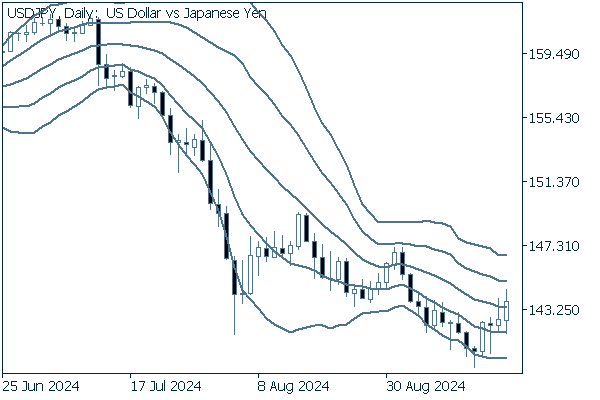

The pair rebounded after breaking below the key support line of 140 yen, and has now broken above the -1σ level of the Bollinger Bands. It can be confirmed that the highs and lows are gradually being lowered.
We continue with an analysis of the USDJPY weekly chart.
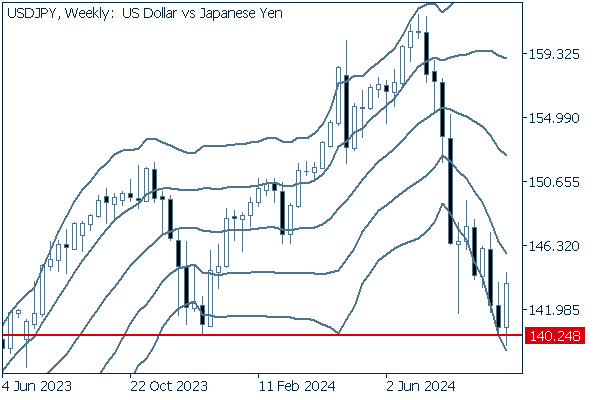

The pair has rebounded since falling below the most recent low of 140.24 yen. In this time frame, it is probably best to go long until the closing price breaks above the -1σ level.
EURUSD
The ECB has also started to lower interest rates. There are no major EUR-related events scheduled for this week.
Next is an analysis of the EURUSD daily chart.
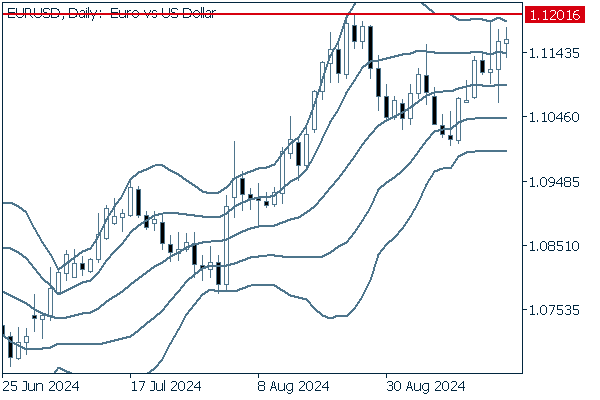

The pair is once again closing in on the most recent high of 1.1201. The middle line of the Bollinger Bands is flat, indicating that there is no trend in the near future.
We continue with an analysis of the EURUSD weekly chart.
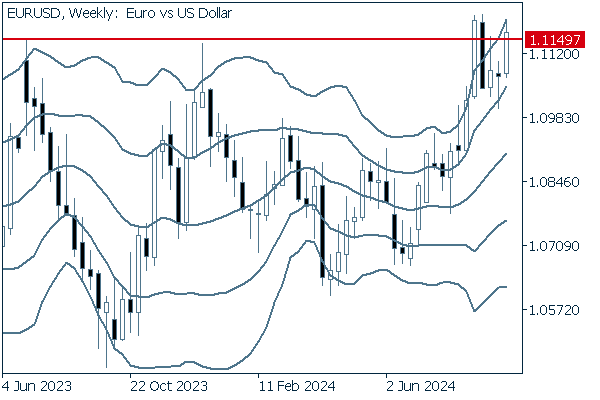

On the weekly chart, the pair is moving below and above the 1.1149 line.
Since the middle line has already turned upwards, a clear break above this line could signal a long term uptrend.
GBPUSD
The Bank of England left interest rates unchanged while its U.S. and European counterparts began to lower rates. There are no major GBP-related events scheduled for this week.
Next is an analysis of the GBPUSD daily chart.
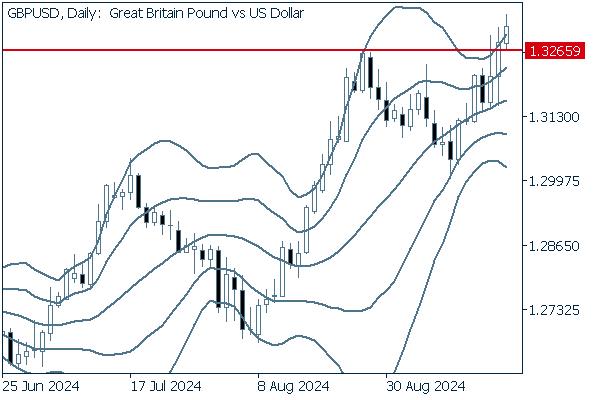

The pair crossed the 1.3265 resistance line on September 19. The following day, the line turned into a support line as the pair hit a new high.
We continue with an analysis of the GBPUSD weekly chart.
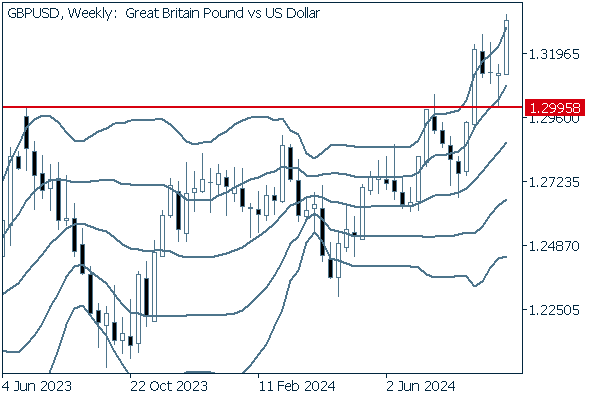

Even on the weekly chart, the pair continues to move above the key resistance level of 1.3.
Was this article helpful?
0 out of 0 people found this article helpful.
Thank you for your feedback.
FXON uses cookies to enhance the functionality of the website and your experience on it. This website may also use cookies from third parties (advertisers, log analyzers, etc.) for the purpose of tracking your activities. Cookie Policy
